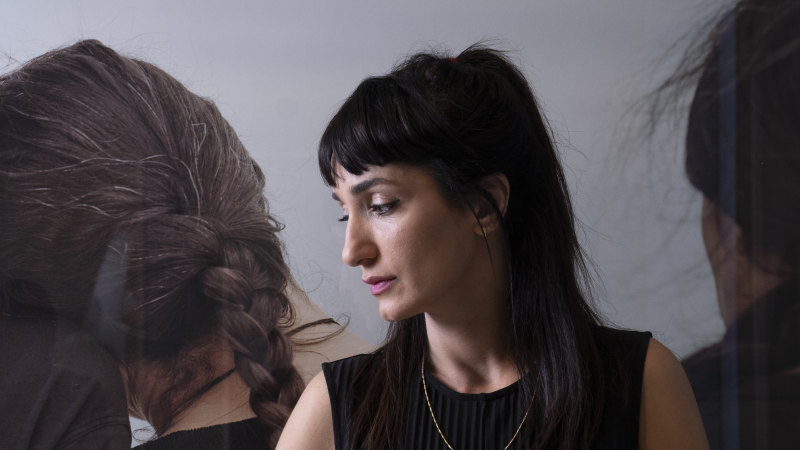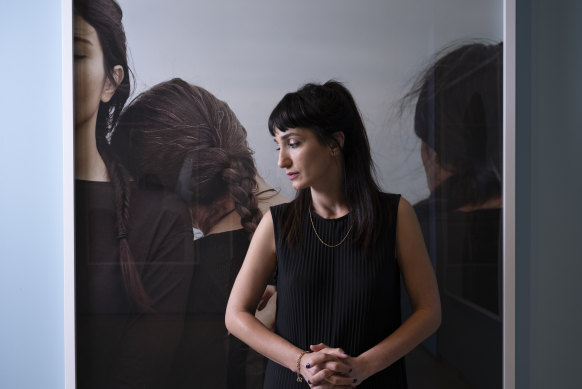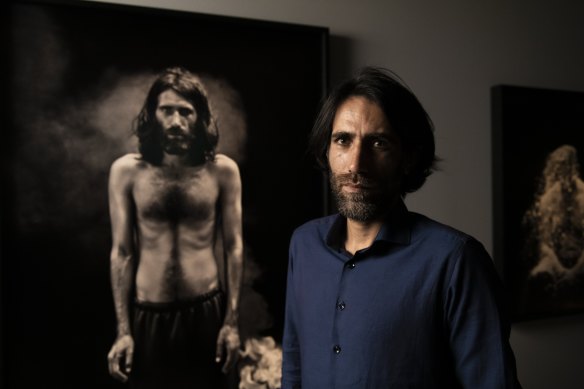Save articles for later
Add articles to your saved list and come back to them any time.
A photograph is a record. A piece of visual evidence. But Hoda Afshar has always understood an image can be deceiving, grasping the difference between capturing a subject and showing what can’t be seen. Growing up in Tehran, Afshar was interested in theatre before going on to study documentary photography. During the mid-noughties she would make pictures of her friends at underground parties, laughing, smoking, reaching for each other.
“I said ‘I want you to tell me how you want me to picture you’,” she says. “They were like ‘how about I move here, put my arms around this person’. I was afraid of telling my teachers, because I was doing a documentary course. So I said ‘this is actually what’s happening’.”
Hoda Afshar with some of her new work in A Curve is a Broken Line.Credit: Janie Barrett
That series, Scene (2004-05), contains, in miniature, the elements that would define Afshar’s work as an artist – the blurring of fact and fiction and the idea the camera can conceal as much as it reveals, a commitment to overturning the belief a photographer has power over the people she’s photographing.
A Curve is a Broken Line, Afshar’s first major public survey, at the Art Gallery of New South Wales until January, traces the arc of these ideas via images that are as lush as they are startling.
When Afshar migrated to Australia in 2007, she was frequently misunderstood.
“Everything in Iran during my upbringing was a challenge, so I basically became a rebel from early on,” she tells me. “But then after migration, my interest in photography shifted.” She pauses. “My experience was ‘we know your story better than you do’. It was always already imagined.”
A front gallery plays host to In the exodus, I love you more (2014 -), made when she returned to Iran after relocating to Australia. A boy draws on a window caked with dust. Figures appear in veils and shrouds. A pair of white horses nuzzle in the mist. We talk about the danger of romanticising a homeland.
Behrouz Boochani stands in front of a portrait of himself, part of Hoda Afshar’s Remain series.Credit: Rhett Wyman
“After you migrate, you try to find a way of belonging to the new place, which you never do, and you lose that sense of belonging to the home country as well. That is something you could mourn – but it frees you from the limitations of the border. You become this kind of floating being in the world. It’s very liberating.”
We’re sitting in a darkened space, home to Afshar’s best-known series, the internationally acclaimed Remain (2018). On one wall, a series of black-and-white portraits features men who had sought refuge in Australia, only to be imprisoned on Manus Island. Light glimmers on their bodies. Ramsiyar, a Tamil refugee, cradles a fish. Behrouz Boochani locks eyes with the viewer. In a two-channel video, opposite, the men recite poetry, recount stories of violence and death and murder against white-sand beaches, crystalline ocean.
“The juxtaposition of beauty and violence was the first thing that stood out to me,” says Afshar, who collaborated with the men on the direction of the images. “That is something Behrouz Boochani and I spoke about, the way in which refugees are denied the right to beauty. Refugees are neither angels or demons. It is allowing them the right to be themselves.”
As a culture, we are desensitised to accounts of trauma. It’s all too easy to turn away. Afshar’s best work involves us in an ethics of looking. What do we choose not to see? Remain led to Agonistes (2020), in which she trained her gaze on whistleblowers, men and women working in immigration, intelligence services, defence and disability care who risked everything to expose abuses of power.
“I wanted to make work about the white Australians who tried to do something,” she says. “And see how society would respond to that. To me, those people are modern tragic figures.”
To make Agonistes, she created 3-D printed sculptures of each whistleblower. When photographed, the eyes were blank. They recalled ancient Greek busts, evoking those failed by democracy. Metaphors haunt Afshar’s images. A Curve is a Broken Line opens with In Turn (2023), a new commission in which image after ravishing image depict Iranian-Australian women such as Afshar. Wearing black, they braid hair, embrace each other, release doves. It responds to the feminist uprising that started in Iran in September 2022 after the death of Mahsa Jina Amini.
“This is what I learned from what women were sharing on social media,” she says. “There was so much poetry. They were standing on bins, holding scarves. These acts of sisterhood – plaiting hair on the streets where there were guards with guns. I was mesmerised.”
The women’s images, Afshar says, were created using mobile phones. Every time they were shared, the quality dropped. So, as when she was starting out, she emphasised what was already there so that it is impossible for a viewer to be unmoved by their courage.
“I used a large-format camera that creates the most detailed images to give the women as much visibility as possible,” she smiles. “It mimics their language. It says ‘we are here, watching you’. It is a visual love poem.”
A Curve is a Broken Line is at the Art Gallery of New South Wales until January 21.
The Booklist is a weekly newsletter for book lovers from books editor Jason Steger. Get it delivered every Friday.
Most Viewed in Culture
From our partners
Source: Read Full Article


